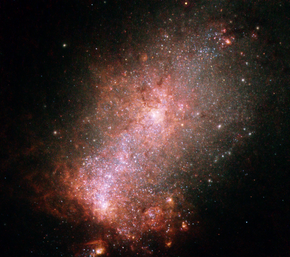NGC 3125
| NGC 3125 | |
|---|---|
 | |
| Observation data (J2000 epoch) | |
| Constellation | Antlia |
| Right ascension | 10h 06m 33s |
| Declination | -29° 56’ 05” |
| Redshift | 0.003712 ± 0.000023 [1] |
| Heliocentric radial velocity | 1113 ± 7 km/s[1] |
| Apparent magnitude (B) | 13.45 |
| Surface brightness | 22.63 mag/arcsec2 |
| Characteristics | |
| Type | S;BCDG [1] |
| Apparent size (V) | 1.1′ × 0.7′ |
| Other designations | |
| ESO 435-G041, AM 1004-294, MCG -05-24-022 | |
NGC 3125 is an irregular dwarf starburst galaxy in the constellation Antlia that was discovered by John Herschel in 1835.[2][3] It is located approximately 38 million light-years away from Earth.[4][5] Starburst galaxies are galaxies in which unusually high numbers of new stars are forming, springing to life within intensely hot clouds of gas.[6]
Morphology
In a 2006 study, the two giant H II regions in the galaxy were confirmed to each host two young star clusters.[2] The brightest cluster, NGC 3125-A1 is a confirmed super star cluster with 170,000 solar masses[7] that likely contains some of the most massive stars every found.[4][5]
Nearby galaxies
NGC 3125 is member of the LGG 189 Group, which also includes the galaxies NGC 3113, NGC 3137, and NGC 3175.[8]
See also
References
- ^ a b c "NASA/IPAC Extragalactic Database". Results for NGC 3125. Retrieved 2024-03-26.
- ^ a b Hadfield, L. J.; Crowther, P. A. (2006-06-01). "How extreme are the Wolf-Rayet clusters in NGC3125?*". Monthly Notices of the Royal Astronomical Society. 368 (4): 1822–1832. arXiv:astro-ph/0602591. Bibcode:2006MNRAS.368.1822H. doi:10.1111/j.1365-2966.2006.10245.x. ISSN 0035-8711.
- ^ "New General Catalog Objects: NGC 3100 - 3149". cseligman.com. Retrieved 2025-02-16.
- ^ a b Wofford, A.; Sixtos, A.; Smith, L.; Charlot, S.; Bruzual, G. (2024-01-01). "NGC 3125-A1 revisited at higher spectral resolution with COS G160M". IAU Symposium. 361: 58–62. Bibcode:2024IAUS..361...58W. doi:10.1017/S1743921322002502.
- ^ a b Plana, Henri; Alves, Vitor G.; Carvalho, Maiara S. (2024-06-01). "The influence of ionized gas kinematics on H II galaxies - the cases of Tol 1004-296 and Tol 0957-278". Monthly Notices of the Royal Astronomical Society. 531 (2): 2881–2902. arXiv:2405.12361. Bibcode:2024MNRAS.531.2881P. doi:10.1093/mnras/stae1327. ISSN 0035-8711.
- ^ Now, Astronomy. "NGC 3125 – Astronomy Now". Retrieved 2024-04-19.
- ^ Wofford, Aida; Leitherer, Claus; Chandar, Rupali; Bouret, Jean-Claude (2014-02-01). "A Rare Encounter with Very Massive Stars in NGC 3125-A1". The Astrophysical Journal. 781 (2): 122. arXiv:1312.5982. Bibcode:2014ApJ...781..122W. doi:10.1088/0004-637X/781/2/122. ISSN 0004-637X.
- ^ Garcia, A. M. (1 July 1993). "General study of group membership. II. Determination of nearby groups". Astronomy and Astrophysics Supplement Series. 100: 47–90. Bibcode:1993A&AS..100...47G. ISSN 0365-0138.
